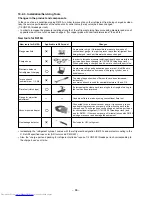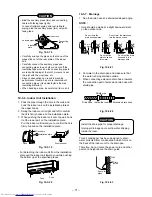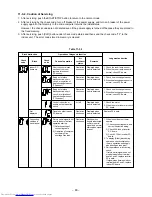
– 80 –
11. HOW TO DIAGNOSE THE TROUBLE
The pulse modulating circuits are mounted to both indoor and outdoor units.
Therefore, diagnose troubles according to the trouble diagnosis procedure as described below.
(Refer to the check points in servicing written on the wiring diagrams attached to the indoor/outdoor units.)
Table 11-1
Fig. 11-1
No.
1
2
3
4
5
6
7
8
9
10
Troubleshooting Procedure
First Confirmation
Primary Judgment
Self-Diagnosis by Remote Controller (Check Code)
Judgment of Trouble by Every Symptom
Check Code 1C (Miswiring in indoor/outdoor units) and 1E
Trouble Diagnosis by Outdoor LED
Troubleshooting
How to Diagnose Trouble in Outdoor Unit
How to Check Simply the Main Parts
How to Simply Judge Whether Outdoor Fan Motor is Good or Bad
Page
81
81
82
85
90
91
92
93
94
99
NOTE :
A large-capacity electrolytic capacitor is used in the
outdoor unit controller (inverter). Therefore, if the
power supply is turned off, charge (charging voltage
DC320V) remains and discharging takes a lot of
time. After turning off the power source, if touching
the charging section before discharging, an electri-
cal shock may be caused. Discharge the electrolytic
capacitor completely by using soldering iron, etc.
< Discharging method >
1. Remove the inverter cover (plating) by opening
four mounting claws.
2. As shown below, connect the discharge resis-
tance (approx. 100W/40W) or plug of the solder-
ing iron to voltage b – terminals of the
C13 (“CAUTION HIGH VOLTAGE 320V” is
indicated.) electrolytic capacitor (500µF/400V)
on P.C. board, and then perform discharging.
Discharging position
(Discharging period
10 seconds or more)
Plug of
soldering iron
Inverter cover
P. C. board
(Soldered surface)
Summary of Contents for RAS-4M23SACV-E
Page 27: ... 27 4 2 Outdoor Unit RAS 4M23SAV E RAS 4M23SACV E ...
Page 114: ... 114 MCC 1438 ...
Page 115: ... 115 MCC 818 ...
















































